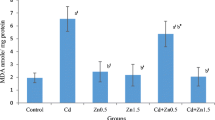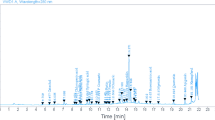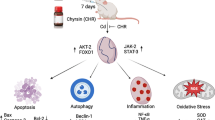Abstract
In this microscopic study, the toxic effects of cadmium (Cd) and the protective role of a zinc (Zn) co-treatment were investigated in the testes of the rats treated with Cd. At the dose and duration used, Cd severely damaged the seminiferous tubules and caused the degeneration and disintegration of spermatogenic cells. Leydig cells were also lost after Cd treatment. The present study showed that zinc co-treatment protected testes against toxic effects of cadmium.
Similar content being viewed by others
Explore related subjects
Discover the latest articles, news and stories from top researchers in related subjects.Avoid common mistakes on your manuscript.
Cadmium (Cd) is a widely spread and highly toxic environmental and industrial toxicant that has a long biological half-life in mammals (WHO 1992). Histological and biochemical studies have shown that acute and chronic exposure to Cd adversely affects a number of organs, including kidney, liver, testis and lung (Klaassen 1999; Yiin et al. 1999; Claveria et al. 2000; Patrick 2003). Trace elements appear to protect toxic effect of heavy metals on the tissue histology. For instance, zinc is essential for testicular function and protects testes against Cd toxicity. Moreover, organ sensitivities to Cd also differ. Rodent testes are especially sensitive to the toxic effects of Cd exposure. Cd impairs reproductive capacity by causing sever testicular degeneration, seminiferous tubule damage and necrosis in rats (Saxena et al. 1989; Waalkes 2000; Xu et al. 2005). Furthermore, several factors are known to contribute to tissue damage; of these, free radicals and oxidative stress play a major role in tissue injury (Yiin et al. 1999). Indeed, Cd treatment leads to oxidative damage in tissues by depleting glutathione and increasing lipid peroxidation levels (Yiin et al. 1999). The cellular and molecular mechanisms involved in the handling and toxicity of Cd in target organs may be mediated largely by proteins such as metallothionein and antioxidants (Klaassen 1999; Xu et al. 2005). Metallothionein (MT), a cysteine-rich cadmium binding protein, protects tissues from heavy metal toxicity and hydroxyl radical attack through sequestration and antioxidising heavy metals (Afonne 2002; Patrick 2003; Xu et al. 2005). Cd accumulation, mainly in the liver, induces MT synthesis, which in turn protects testes against Cd toxicity (Patrick 2003; Xu et al. 2005). Moreover, zinc (Zn) is an antioxidant trace element that is present in all organs, tissues, and fluids of the body. Zn is required for cell proliferation, differentiation, normal growth, immune functions, and wound healing (Rotsan et al. 2002). Zn is an essential mineral for spermatogenesis and a hepatocellular MT inducer, and zinc co-treatment protects tissues against free radicals and oxidative stress (Afonne 2002). The beneficial role of zinc against cadmium-induced testicular damage has also been reported, although its antioxidant mechanism is unclear (Batra et al. 1998; Claveria et al. 2000; Rotsan et al. 2002; Xu et al. 2005). Nevertheless, several mechanisms have been proposed for zinc. One mechanism is that zinc’s protection of the testes is mediated by the induction of MT against heavy-metal toxicity (Batra et al. 1998; Afonne 2002; Xu et al. 2005). Alternatively, zinc may directly antagonize the toxic effects of Cd and/or stabilize cell membranes and protect lipid peroxidation by free radicals (Yiin et al. 1999; Waalkes 2000; Rotsan et al. 2002; Patrick 2003). Since zinc is known to have antioxidant effects, in the present study we investigated whether zinc has protective effect against Cd toxicity in testes.
Materials and Methods
The aim of this study was to examine morphological changes in the testes of cadmium-treated rats and the effect of zinc co-treatment on those changes. For this purpose, in the present study, 21 male Spraque-Dawley rats weighing 250–300 g were obtained from the Medical and Surgical Research Center (TICAM) of Eskisehir Osmangazi University, Eskisehir, Turkey. The animals were housed in individual cages at standard temperature (24 ± 2°C) with a 12-hr light/dark cycle and received standard pelleted rat food (Oguzlar Food Company, Eskisehir-Turkey) and drinking water ad libitum for 30 days. The animals were divided into three groups, each containing seven animals (n = 7). The first group of animals were used as controls and received water only. The second group received 15 ppm cadmium chloride monohydrate (CdCl2, Himedia, India), and the third group received 15 ppm CdCl2 + 30 ppm zinc chloride (ZnCl2, Carlo Erba, Italy) via drinking water (Asar et al. 2004). Fluid intake was monitored every two days. At the end of the experiment, the animals were anesthetized with intraperitoneal injection of pentobarbital (65 mg/kg) and were sacrified by exsanguination. Testes were fixed in 2.5% glutaraldehyde-phosphate buffer solution, postfixed in 2% osmium tetraoxide (OsO4), dehydrated with graded alcohols, and embedded in Araldite CY212. For light microscopy, semithin sections of testicular tissue were stained with Toludine blue, examined with an Olympus BH-2 light microscope and photographed with an Olympus DP-70 digital camera (Olympus, Tokyo, Japan). For ultrastructural observation, ultrathin sections were stained with lead citrate and uranyl acetate and examined with a JEOL-1220 transmission electron microscope (JEOL, Tokyo, Japan).
Results and Discussion
This study was designed to examine the protective effect of zinc against Cd-induced changes in testes. Examination of control testes revealed intact interstitium and seminiferous tubules containing all stages of spermatogenesis (Fig. 1a, b). Cd treatment caused severe damage in the seminiferous tubules and testicular interstitium. Germinal cell loss and moderately necrotic tubules were noted as well. In addition to the observation of highly congested blood vessels, edema, cell infiltration, fibrotic changes, and large numbers of lipid granules, no Leydig cells were seen in this group (Fig. 1c, d, Fig. 2 a, b). When Zn and Cd were used together, zinc protected testes from Cd-induced changes. Although minimal vacuolization was observed between spermatogenic cells, all stages of spermatogenic cells and spermatozoa were present in the tubules. Spermatogenic and Sertoli cells displayed intact cell membranes, prominent nuclei, and densely stained chromatin. The basal lamina was well preserved. In the Zn co-treated group, the interstitium and Leydig cells were also well preserved. Leydig cells present in the interstitium could be identified by their typical darkly stained lipid content and distinct nuclei (Fig. 1e–h, Fig. 2c, d).
Toxic effects of Cd on testicular tissue and the protective effect of Zn co-treatment against Cd toxicity examined at light microscopic level. Control-group testes show well-organized seminiferous tubules, spermatogenic cells and interstitium (a, b). Testes from rat received 15 ppm cadmium chloride monohydrate show degeneration of spermatogenic cells and total absence of Leydig cells (c, d). Testes from rat received 15 ppm CdCl2 and 30 ppm zinc chloride show intact seminiferous tubules (e, f). Figures from same group showing numerous intact Leydig cells and well-organized spermatogenic cells (→) (g, h). Toluidine blue staining was used
Noxious effects of Cd on testicular tissue and the mitigating effect of Zn co-treatment against Cd toxicity analyzed using transmission electron microscopy (TEM). Electron micrographs taken from the group receiving Cd show damaged spermatogenic cells and interstitium, thickened basal lamina (→), and increased collagen (→) (a, b). Representative figures from the group received 15 ppm CdCl2 and 30 ppm zinc chloride, showing intact Leydig cells (L), Sertoli cells (S), prominent basal lamina (c), intact spermatogonia and primary spermatocytes (→) (d)
Studies on Cd toxicity have shown that, compared to other organs, rodent testes are extremely susceptible to Cd (Saxena et al. 1989; Klaassen 1999; Claveria et al. 2000; Xu et al. 2005). In rats, Cd-induced testicular damage observed by histological examinations include seminiferous tubule degeneration, impaired reproductive capacity, and reduced sperm production (Yiin et al. 1999; Waalkes 2000; Patrick 2003; Xu et al. 2005). In our study, we examined the effect of zinc co-treatment on the testicular histology of the rats exposed to Cd orally in drinking water for 30 days. Our results clearly showed that, at the dose and duration we used, Cd severely damaged the seminiferous tubules, including degeneration and disintegration of spermatogenic cells. Our findings were consistent with other studies and further supported their observations (Batra et al. 1998; Klaassen 1999; Afonne 2002). Furthermore, an interesting observation in this study was the loss of Leydig cells after Cd treatment. In fact, few studies have been reported regarding disturbances in spermatogenesis with degeneration of Leydig cells in lead-intoxicated rats (Saxena et al. 1989). Hence, our results suggest that cadmium affects not only the seminiferous tubule but also the Leydig cells, indicating that the potential sites where Cd affects the testes are probably multiple. Cd exerts its toxicity on tissues via different pathways. Cd is known to induce oxidative stress by depletion of glutathione and an increase of lipid peroxidation levels (Yiin et al. 1999). Bioactive chemicals such as MT, an antioxidant agent, are known to be involved in protection of testes against Cd-associated oxidative damage (Yiin et al. 1999; Xu et al. 2005; Afonne 2002). However, testes produce less MT in response to Cd accumulation than liver. Therefore, this might account for the higher susceptibility of testes to Cd toxicity (Patrick 2003; Xu et al. 2005). MT protects rat testes against Cd toxicity by sequestering and antioxidating toxins (Xu et al. 2005). Therefore, while the modest levels of MT induced by low doses of Cd can have protective effects against heavy-metal toxins, at high doses of Cd, MT fails to protect testes due to the insufficient amount present to bind heavy metals. Zinc is another well-known antioxidant. It is not only an essential trace element that is present in all organs and tissues but also plays important roles in many body functions including testosterone production and spermatogenesis (Afonne 2002; Rotsan et al. 2002). Furthermore, zinc, natural antagonist to Cd, reduces toxic effects of Cd with an antioxidant mechanism that has not been well understood (Batra et al. 1998, Claveria et al. 2000). Nevertheless, several mechanisms have been proposed for zinc. One mechanism is that zinc may stabilize lipid membranes and protect lipid peroxidation by free radicals, thereby protecting tissues (Batra et al. 1998; Rotsan et al. 2002; Xu et al. 2005). Alternatively, zinc may induce hepatocellular metallothionein (MT), which is a well-known cadmium binding protein, consequently protecting tissues against Cd toxicity (Batra et al. 1998; Yiin et al. 1999; Claveria et al. 2000; Rotsan et al. 2002). In conclusion, in the present study, zinc played a protective role against cadmium toxicity in rat testes. However, further studies are needed to elucidate the mechanism of this protection.
References
Afonne OJ, Orisakwe OE, Ekanem IA (2002) Zinc protects chromium-induced testicular injury in mice. Indian J Pharmacol 34:26–31
Asar M, Kayisli UA, Izgut-Uysal VN, Akkoyunlu G (2004) Immunohisto-chemical and ultrastructural changes in the renal cortex of cadmium-treated rats. Biol Trace Elem Res 97:249–263
Batra N, Nehru B, Bansal MP (1998) The effects of zinc supplementation on the effects of lead on the rat testis. Reprod Toxicol 12:535–540
Claveria C, Corbella R, Martin D, Diaz C (2000) Protective effects of Zinc on Cadmium Toxicity in Rodents. Biol Trace Elem Res 75:1–3
Klaassen CD, Liu J, Choudhuri S (1999) Metallothionein: an intracellular protein to protect against cadmium toxicity. Annu Rev Pharmacol Toxicol 39:267–294
Patrick L (2003) Toxic metals and antioxidants: part II, the role of antioxidants in arsenic and cadmium toxicity. Altern Med Rev 8:106–128
Rostan EF, Debuys HV, Madey DL, Pinnell SR (2002) Evidence supporting zinc as an important antioxidant for skin. Int J Dermatol 41: 606–611
Saxena SK, Murthy RC, Singh C, Chandra SV (1989) Zinc protects testicular injury induced by concurrent exposure to cadmium and lead in rats. Res Comm Chem Pathol Pharmacol 64:317–329
Waalkes MP (2000) Cadmium Carcinogenesis in review. J Inorg Biochem 79: 241–244
World Health Organization (1992) Cadmium Environmental Health Criteria. WHO Geneva, Switzerland
Xu LC, Sun H, Wang S, Song L, Chang HC, Wang XR (2005) The roles of metallothionein on cadmium-induced testes damages in Sprage-Dawley rats. Environ Toxicol Pharmacol 20:83–87
Yiin SJ, Chern CL, Sheu JY, Lin TH (1999) Cadmium induced lipid peroxidation in rat testes and protection by selenium. Biometals 12:353–359
Author information
Authors and Affiliations
Corresponding author
Rights and permissions
About this article
Cite this article
Burukoğlu, D., Bayçu, C. Protective Effects of Zinc on Testes of Cadmium-Treated Rats. Bull Environ Contam Toxicol 81, 521–524 (2008). https://doi.org/10.1007/s00128-007-9211-x
Received:
Accepted:
Published:
Issue Date:
DOI: https://doi.org/10.1007/s00128-007-9211-x






